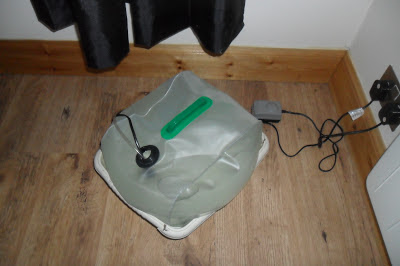I have not been able to repeat the reduction in cyanobacteria observed in this post using aged water (see Chapter 23).
I had come to believe, that there was something about my tap water, in the context of the biochemistry of my fish tank, that inevitably led to the dominance of cyanobacteria. From my reading of the reef forums I knew that many people had found it necessary to completely control the chemistry of their tank water in order to keep sensitive corals in reef tanks. They used reverse osmosis water or distilled water, in which practically all dissolved substances have been removed. They then add added back all the necessary dissolved buffering substances and trace elements etc. at known concentrations. In this way they didn't have to worry about their tap water affecting their ecosystems. I was surprised that I would have to go to the same trouble as a reef keeper in order to keep assorted Tetra and a moss ball but that's life. I bought a 20 liter camping water container and a product called Tropic Marin re-mineral tropic. Here is the blurb.
Tropic Marin's Re-Mineral Tropic adds all natural minerals and substances which are vital for the well-being of the fish and lush vegetation and the reverse osmosis water gets back all its beneficial natural minerals and substances. At the same time the carbonate hardness is raised and stabilized at its optimal value. Re-Mineral Tropic is also excellent for aquarium conditioning of soft tap water, rain water and other soft water. Pure natural composition. No by-products. no nitrates. no phosphates.Carbonate hardness determines waters ability to buffer against changes in pH that would occur as a result of the many biochemical reactions that generate Hydrogen (H+) ions.
I planned to use distilled water from work, heat it to tank temperature with a small 25W heater, add the minerals and use it for water changes. At this point Arthur intervened.
Over the years I have asked for advice from local fish-keepers about my cyano problems. The guy at my local fish shop explained to me that excess nitrates and phosphates were probably the cause and advised me to buy nitrate and phosphate adsorbing media for my filter. A couple of fish-keepers at work explained that direct sunlight was probably the problem or that sometimes you are just unlucky and get a cyano infection. But Arthur said something different, something new. Arthur has kept tropical fish for 40 years and in that time has seen it all in fish-keeping. He made two points. Firstly, that weekly 37% water changes was too often and secondly, not to use fresh tap water for a water change. Instead use water that had been allowed to stand for at least a week. I thought it was an interesting idea because at the time, I had been reading about bacterial blooms in fish-tanks. Anyone who has set a a new tank will tell you that in the first week you can get milky water and a film of bacteria develops on the tank surfaces. Both usually go away naturally as the tank matures. From what I read the blooms were heterotrophic bacteria (bacteria that use organic compounds as food rather than autotrophic bacteria like cyano). It seemed logical to me that adding water that already had an established bacterial population to the tank might change the ecology of the tank and tip the balance away from the cyano. Or that the heterotrophs would deplete the water of mystery substance X and limit cyano growth as a result. In order to encourage bacteria to grow I added an air stone and the heater to 20 liters of water and left it for a week.
 |
| The water carrier needs to be supported or spillages can occur, here I'm using a washing-up basin. |
 |
| Week 114. After two AW changes. 50% gravel coverage, cyano on tank walls, bog-wood and plants. |
 |
| Week 115. 5% gravel coverage, tank walls largely clear, some cyano on the bog-wood , plants heavily coated. |
 |
| Week 116. Gravel clear, tank walls and bog-wood mainly clear, biofilm on the plants showing signs of breaking down |
 |
| Until at last I threw my enemy down, and smote his ruin on the mountainside. |
No comments:
Post a Comment